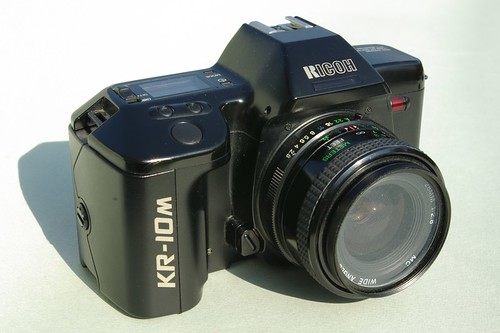Difference between revisions of "Ricoh KR-10M"
(begun stub using CW pool pic) |
(noting name variants; another link) |
||
| Line 8: | Line 8: | ||
|image_rights= wp | |image_rights= wp | ||
}} | }} | ||
| − | The '''KR-10M''' is an [[SLR]] for [[35mm film]] sold by [[Ricoh]] beginning c.1991. This was the more electronically-oriented alternative to the [[Ricoh KR-5 Super II]], which was available concurrently. Both accept manual-focus [[K mount lenses]], but the "M" indicates one key difference: Motorized film advance and rewind, requiring four AA batteries (contained within the large grip for the photographer's right hand). | + | The '''KR-10M''' is an [[SLR]] for [[35mm film]] sold by [[Ricoh]] beginning c.1991. In some markets it was sold as the '''XR-10M''' or the '''XR-X 2000'''. |
| + | |||
| + | This was the more electronically-oriented alternative to the [[Ricoh KR-5 Super II]], which was available concurrently. Both accept manual-focus [[K mount lenses]], but the "M" indicates one key difference: Motorized film advance and rewind, requiring four AA batteries (contained within the large grip for the photographer's right hand). | ||
The KR-10M also offers [[aperture-priority]] autoexposure, in addition to metered manual exposure settings. Film speeds are detected using [[DX coding]] to set the exposure meter correctly. The top deck displays shutter speeds, frame numbers, and other settings using an electronic LCD, which includes the all-important battery level indicator. Rather than a dial, rocker buttons are used for manual shutter speed selection. Electronic control permits an extended choice of shutter speeds, from 1/2000 sec to 16 seconds (in manual mode) or 32 seconds (with autoexposure). A three-exposure auto-bracketing function is also provided. | The KR-10M also offers [[aperture-priority]] autoexposure, in addition to metered manual exposure settings. Film speeds are detected using [[DX coding]] to set the exposure meter correctly. The top deck displays shutter speeds, frame numbers, and other settings using an electronic LCD, which includes the all-important battery level indicator. Rather than a dial, rocker buttons are used for manual shutter speed selection. Electronic control permits an extended choice of shutter speeds, from 1/2000 sec to 16 seconds (in manual mode) or 32 seconds (with autoexposure). A three-exposure auto-bracketing function is also provided. | ||
| Line 14: | Line 16: | ||
==Links== | ==Links== | ||
*[http://www.butkus.org/chinon/ricoh/kr-10m/kr-10m.htm Ricoh KR-10M online manual] from Mike Butkus' [http://www.butkus.org/chinon/ OrphanCameras.com] | *[http://www.butkus.org/chinon/ricoh/kr-10m/kr-10m.htm Ricoh KR-10M online manual] from Mike Butkus' [http://www.butkus.org/chinon/ OrphanCameras.com] | ||
| + | *[http://www.butkus.org/chinon/ebay/ricoh_xr-10m.htm XR-10M name variant] pictured at [http://www.butkus.org/chinon/ OrphanCameras.com] | ||
Revision as of 20:41, 26 September 2011

|
| image by rockershot (Image rights) |
The KR-10M is an SLR for 35mm film sold by Ricoh beginning c.1991. In some markets it was sold as the XR-10M or the XR-X 2000.
This was the more electronically-oriented alternative to the Ricoh KR-5 Super II, which was available concurrently. Both accept manual-focus K mount lenses, but the "M" indicates one key difference: Motorized film advance and rewind, requiring four AA batteries (contained within the large grip for the photographer's right hand).
The KR-10M also offers aperture-priority autoexposure, in addition to metered manual exposure settings. Film speeds are detected using DX coding to set the exposure meter correctly. The top deck displays shutter speeds, frame numbers, and other settings using an electronic LCD, which includes the all-important battery level indicator. Rather than a dial, rocker buttons are used for manual shutter speed selection. Electronic control permits an extended choice of shutter speeds, from 1/2000 sec to 16 seconds (in manual mode) or 32 seconds (with autoexposure). A three-exposure auto-bracketing function is also provided.
Links
- Ricoh KR-10M online manual from Mike Butkus' OrphanCameras.com
- XR-10M name variant pictured at OrphanCameras.com